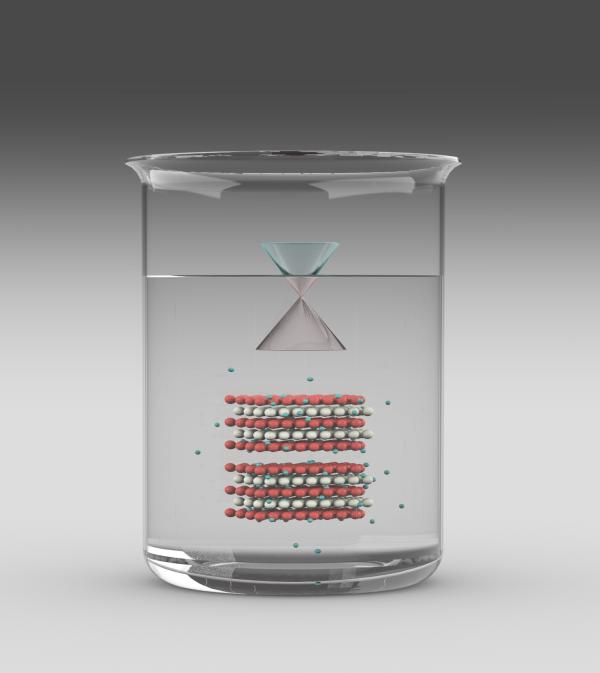
Rendering of hydrogenation resolving an outstanding challenge in chalcogenide classes of three-dimensional (3D) topological insulators and magnets. Image by Lukas Zhao.
A team led by City College of New York physicist Lia Krusin-Elbaum is behind breakthrough research that could open a breadth of new quantum device platforms for harnessing emergent topological states for nano-spintronics and fault-tolerant quantum computing.
The group of physicists and chemists has invented a new facile and powerful technique that uses ionic hydrogen to reduce charge carrier density in the bulk of three-dimensional (3D) topological insulators and magnets. The result is that robust non-dissipative surface or edge quantum conduction channels can be accessed for manipulation and control. Their research, “Topological surface currents accessed through reversible hydrogenation of the three-dimensional bulk,” appears in the journal “Nature Communications.”
The novel hydrogen-tuning technique of chalcogen-based topological materials and nanostructures implemented in a laboratory chamber uses insertion and extraction of ionic hydrogen from dilute aqueous hydrochloric acid (HCl) solution, which leaves the layered topological crystal structure as well as electronic bands intact and has an extra benefit of removing native surface oxide while passivating surfaces. In this process — which the City College team tests in the Krusin Lab for two-dimensional electrical transport — electrons are donated by a reversible binding of H+ ions to chalcogens, such as Te or Se, and bulk carrier densities are reduced by orders of magnitude to achieve access to robust topological surface states without altering carrier mobility or the bandstructure.
“The main advance of this work is that the new hydrogenation process is fully reversible, as hydrogen-chalcogen moiety can be disassociated by a low-temperature annealing protocol under which hydrogen is easily removed,” said Krusin-Elbaum, professor in CCNY’s Division of Science. “It is also multiply-cyclable and reproducible, thereby resolving one of the key limitations of magnetic and nonmagnetic topological insulators and can be applied not only post-growth to materials but also to fully fabricated nanodevices.”
The research in the Krusin Lab centers on exploring novel quantum phenomena such as Quantum Anomalous Hall (QAH) effect, which describes an insulator that conducts dissipationless current in discrete channels on its surfaces, 2D superconductivity, and axion state phenomena featuring a quantized thermal transport, all with the potential if industrialized to advance energy-efficient technologies.
Krusin-Elbaum and her team said that the technique they have demonstrated is very general and ultimately may advance the potential of intrinsic topological magnets to transform future quantum electronics.
The CCNY-based Harlem Center for Quantum Materials is a partner in the research. It strives to solve fundamental problems in novel functional materials systems that have vital scientific and technological importance. The research is supported in part by the National Science Foundation.
About the City College of New York
Since 1847, The City College of New York has provided a high-quality and affordable education to generations of New Yorkers in a wide variety of disciplines. CCNY embraces its position at the forefront of social change. It is ranked #1 by the Harvard-based Opportunity Insights out of 369 selective public colleges in the United States on the overall mobility index. This measure reflects both access and outcomes, representing the likelihood that a student at CCNY can move up two or more income quintiles. In addition, the Center for World University Rankings places CCNY in the top 1.8% of universities worldwide in terms of academic excellence. Labor analytics firm Emsi puts at $1.9 billion CCNY’s annual economic impact on the regional economy (5 boroughs and 5 adjacent counties) and quantifies the “for dollar” return on investment to students, taxpayers and society. At City College, more than 16,000 students pursue undergraduate and graduate degrees in eight schools and divisions, driven by significant funded research, creativity and scholarship. CCNY is as diverse, dynamic and visionary as New York City itself. View CCNY Media Kit.
Jay Mwamba
p: 212.650.7580
e:
jmwamba@ccny.cuny.edu